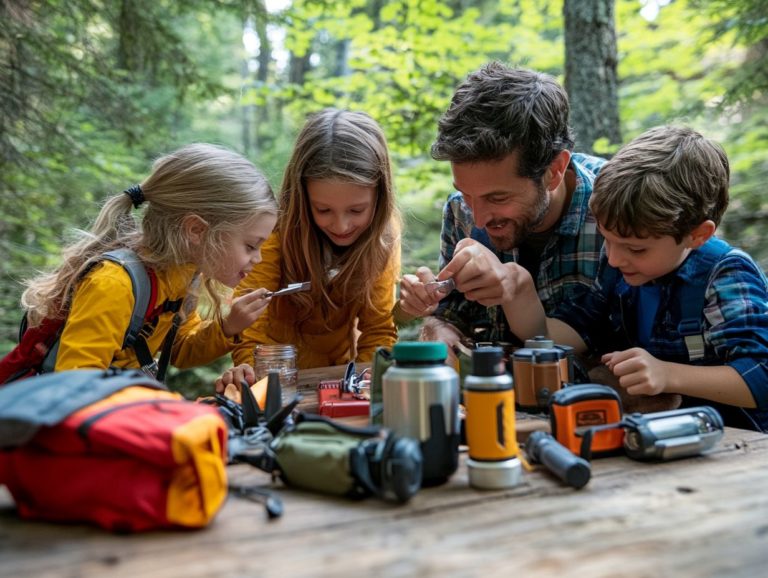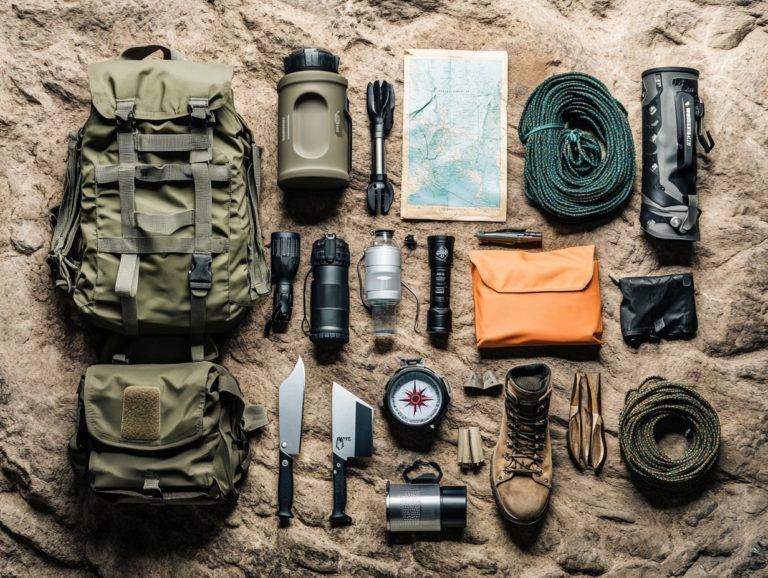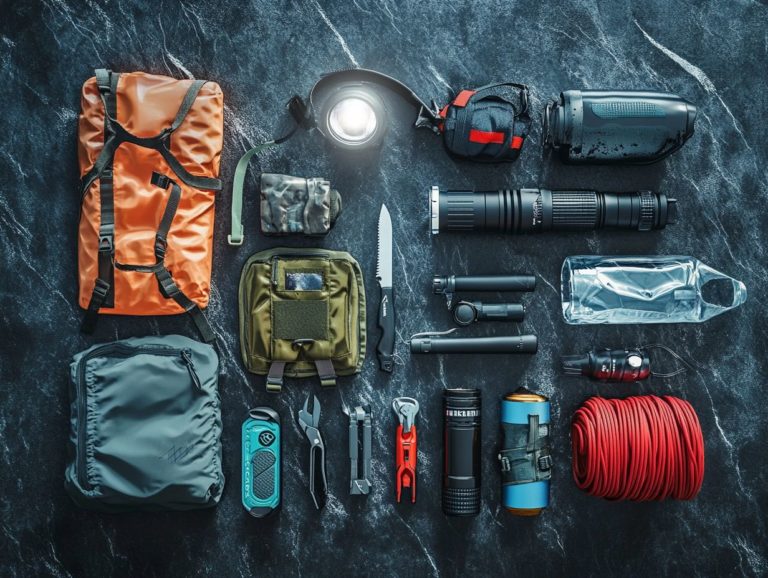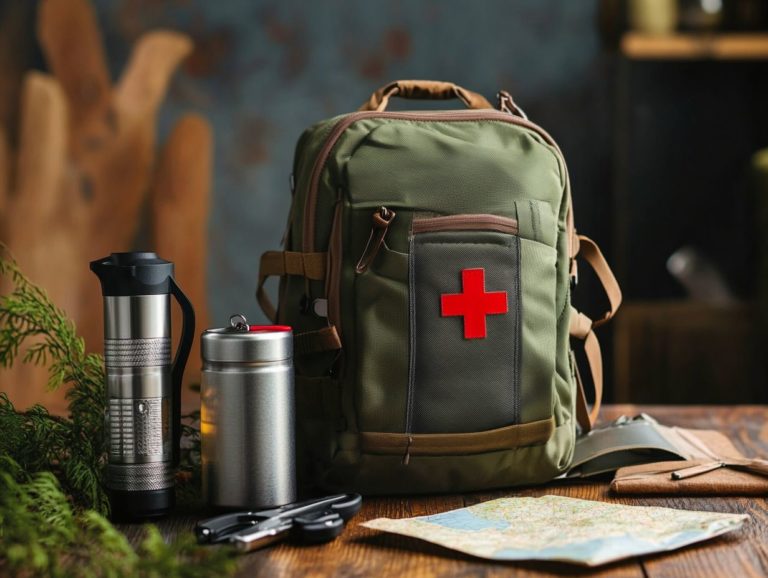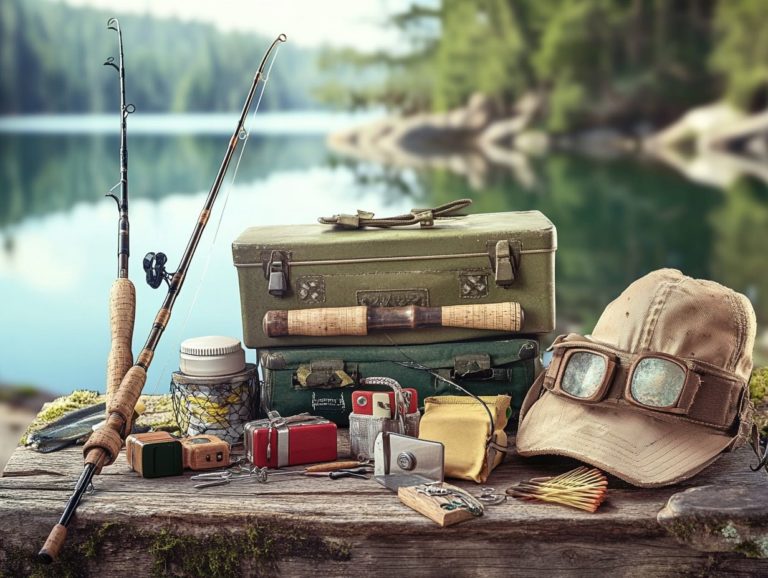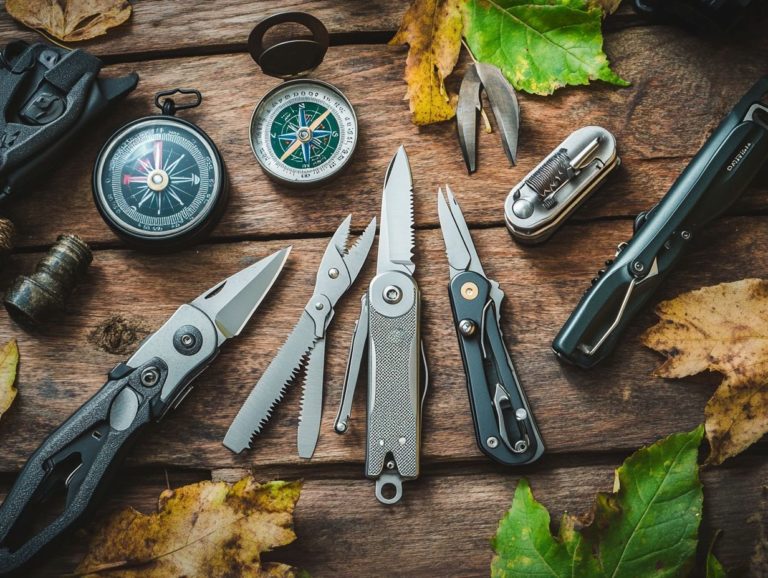Survival Gear for Your Pet in Emergencies
In times of crisis, your pet’s safety is just as vital as your own. Preparing an emergency kit specifically for your four-legged companions can truly make a world of difference, offering both comfort and essential supplies when they are needed most.
This guide outlines everything from crucial food and water provisions to medications, first aid items, and comfort supplies. You’ll discover valuable tips on how to prepare for emergencies and ensure your pampered pooch is ready to face the unexpected.
Dive in to craft a comprehensive emergency plan for your beloved companion.
Contents
- Key Takeaways:
- 1. Essential Items for Your Pet’s Emergency Kit
- 2. Food and Water Supplies for Your Pet
- 3. Medications and First Aid Supplies for Your Pet
- 4. Comfort and Safety Items for Your Pet
- 5. Identification and Important Documents for Your Pet
- 6. Tips for Preparing Your Pet for an Emergency
- Frequently Asked Questions
- What is survival gear for pets in emergencies?
- Why is it important to have survival gear for your pet in emergencies?
- What should be included in a pet’s emergency survival kit?
- Can I use my own emergency supplies for my pet?
- How often should I check and update my pet’s emergency supplies?
- Can I make my own survival gear for my pet in emergencies?
Key Takeaways:
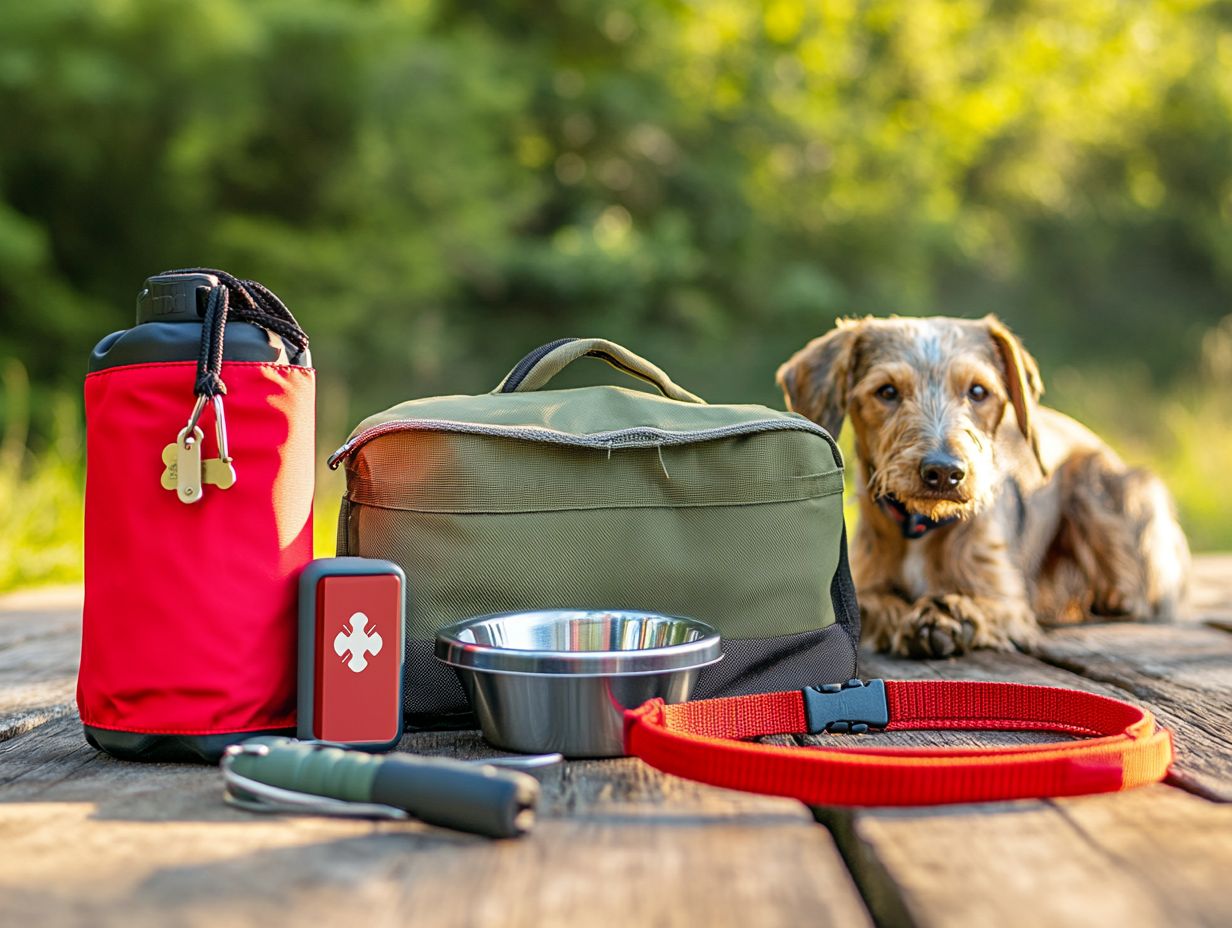
- Pack a comprehensive emergency kit for your pet, including essential items, food and water supplies, medications and first aid supplies, comfort and safety items, and identification and important documents.
- Make sure to include enough food and water for your pet, along with long-lasting options. Pack necessary medications for any existing health conditions.
- Train your pet for emergency situations to ensure their safety during evacuations.
1. Essential Items for Your Pet’s Emergency Kit
Creating a comprehensive emergency kit for your beloved four-legged companions is essential. It acts as a lifeline during unexpected situations.
This kit arms you with vital supplies such as a Pet First Aid Kit, disposal bags, and an emergency blanket. These items can significantly enhance your pet’s well-being, whether you re at home, in the car, or on hiking trips. Preparing this kit keeps your pet safe and gives you peace of mind.
To ensure you’re thoroughly prepared, include items like bandages, cleaning wipes, and even a digital thermometer to check your pet’s temperature. These essentials will allow you to quickly assess your pet’s health when time is of the essence.
Organizing all these supplies in a durable zippered pouch makes them easily accessible during critical moments. Keeping eco-friendly disposal bags within reach promotes responsible pet ownership. Cohesive bandages provide effective support for any injuries. In terms of quality, the Echo-Sigma brand truly stands out, offering reliable products that every pet owner can trust in times of need.
What Should Be Included in Your Pet’s Emergency Kit?
Your pet’s emergency kit should be equipped with essential first aid supplies, including a Pet First Aid Kit, along with crucial items like cleaning wipes and bandages to effectively handle any medical issues that may arise.
Consider including:
- Sterile gauze pads
- Adhesive tape
- Antibiotic ointment
- Tweezers for removing splinters or ticks
- Scissors for cutting bandages or clothing
- Muzzle to prevent bites in stressful situations
Each of these items is vital for ensuring your cherished companion receives timely and effective care until professional help arrives.
How to Store and Maintain Your Pet’s Emergency Kit?
Storing and maintaining your pet’s emergency kit is crucial for ensuring easy access during critical situations. Utilizing a zippered pouch for organization can significantly enhance your preparedness.
It’s advantageous to organize items by category think first aid supplies, food, medications, and comforting toys that ease anxiety. Labeling each section will save you precious time when urgency strikes, allowing you to find exactly what you need with minimal fuss.
Regularly checking the kit ideally every few months is essential. This is your chance to replace any expired food or medications and reassess what your pet might need based on any changes in health or behavior. This proactive approach keeps your kit current and ensures you re always ready for the unexpected.
2. Food and Water Supplies for Your Pet
When preparing for emergencies, prioritizing food and water supplies for your pet is essential, as it ensures they remain nourished. This helps your canine companion stay nourished, especially during unexpected situations where regular feeding may be disrupted.
It’s crucial to pack sufficient amounts of long-lasting food options that meet your pet’s dietary requirements while also considering portable solutions for easy access, such as a silicon bowl. Calculate your pet s daily intake based on their size and activity level. Don t forget to include both regular meals and any additional needs that might arise during emergencies. A solid guideline is to have at least one day’s worth of food for each day you might be away from home, plus a little extra for those unplanned delays.
Focus on lightweight yet nutrient-rich options like freeze-dried meals or high-quality kibble. Don t forget to pack a portable water container to keep your furry friend refreshed and ready for every adventure!
How Much Food and Water Should You Pack for Your Pet?
Determining the right amount of food and water to pack for your pet during emergencies is crucial for ensuring their comfort and nourishment.
Begin by assessing your furry companion’s size, weight, and overall activity level. A good rule of thumb is to provide one ounce of water for every pound of body weight each day. In terms of food, daily requirements can vary significantly; for instance, a high-energy dog may need more sustenance, while a more sedentary pet may require less. For active pets, aim for approximately 30 calories per pound, adjusting based on their unique lifestyle needs, and ensure you have a dog lead handy for walks.
By tailoring these calculations to your pet’s specific requirements, you can significantly enhance their comfort and health in any situation.
What Are Some Long-Lasting Food Options for Your Pet?
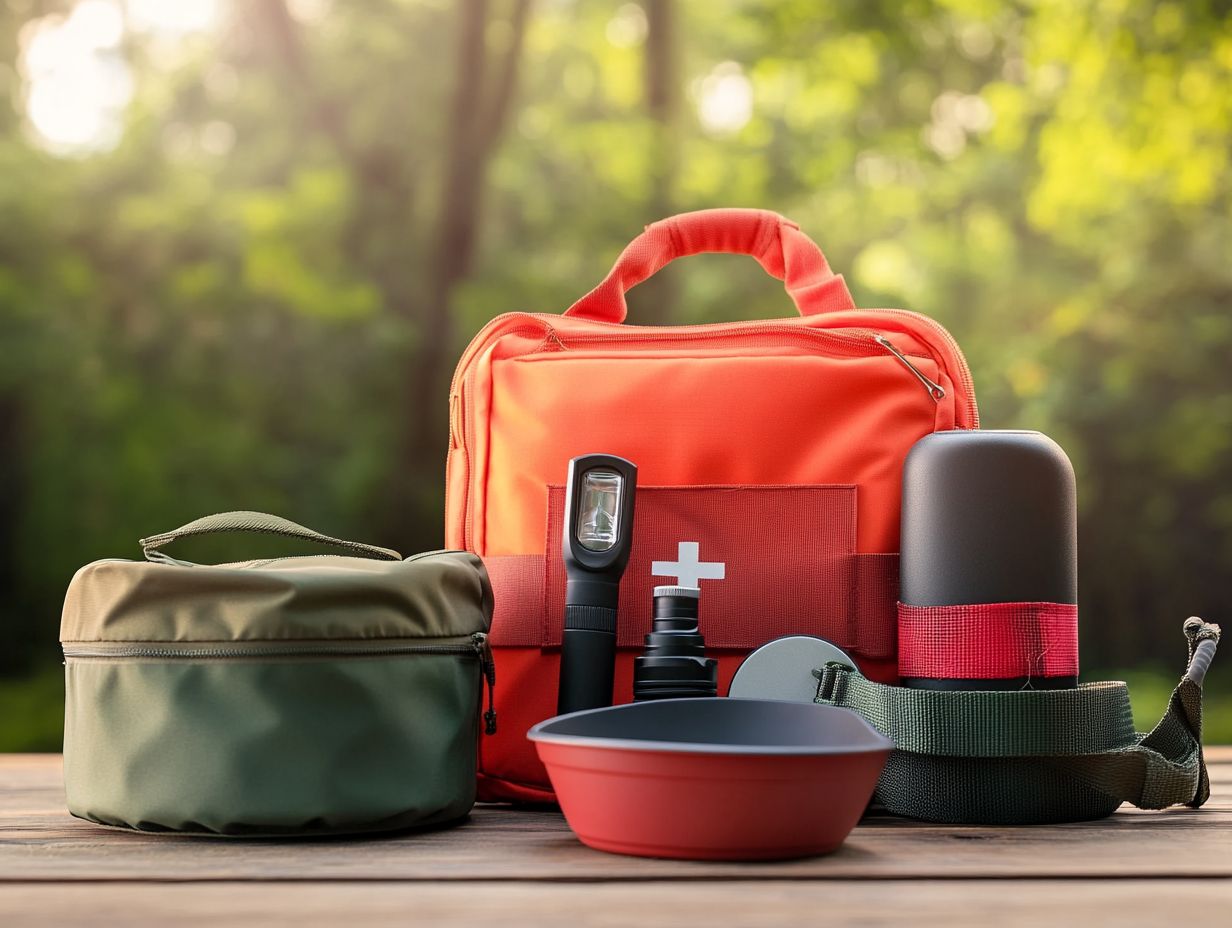
Selecting long-lasting food options for your pet is essential to ensure their safety and nutrition during emergencies, allowing you to focus on managing the situation without the added worry of food spoilage. Options like canned pet food or dehydrated meals are excellent choices.
With an array of choices at your disposal, you can opt for dehydrated meals that keep vital nutrients intact while being lightweight and easily storable perfect for those unexpected moments. Canned pet food is another dependable option; its sealed containers boast an impressive shelf life and can deliver complete nutrition, providing you with peace of mind when the unforeseen occurs.
Freeze-dried food retains its natural flavors and nutrients, allowing for long-term storage making it an ideal choice for those who prioritize quality in every bite, even when times get challenging.
3. Medications and First Aid Supplies for Your Pet
In critical situations, having the right medications and first aid supplies for your pet is absolutely essential, especially for emergencies involving snake bites. This preparation ensures that you can swiftly address any medical emergencies that may arise, whether you need to administer saline, a saltwater solution used for hydration, or apply bandages that stick well on wounds. It’s wise to include an instruction card in your kit that guides you through the necessary steps for your four-legged friend s safety and well-being.
Including items like adhesive dressings is key; they help secure any bandages in place, minimizing movement that could aggravate an injury. A special blanket that keeps pets warm can be a true lifesaver, helping to maintain body heat during instances of shock or trauma.
When faced with a crisis, it’s crucial to remain calm and meticulously follow the instructions at hand. This structured approach not only provides immediate care but also lays the groundwork for further veterinary assistance.
Regularly reviewing and replenishing your pet’s first aid supplies allows you to be prepared for any scenario, ultimately safeguarding their health and granting you the peace of mind you deserve. Take a moment today to review your pet’s first aid kit. Your furry friend will thank you!
What Medications Should You Pack for Your Pet?
Packing essential medications for your pet is vital. It ensures their health and safety during emergencies, allowing for immediate care when unexpected situations arise, such as those requiring saline solution for hydration.
In moments where every second counts, having the right medications can truly make all the difference. For example, allergy medications are critical for alleviating allergic reactions. Additionally, pain relievers can provide much-needed comfort in the event of an injury.
If your pet requires ongoing prescriptions due to specific health conditions, prioritizing these medications is essential. By taking the time to prepare, you’re not only safeguarding your furry companion but also securing peace of mind for yourself.
How to Administer First Aid to Your Pet in an Emergency?
Understanding how to administer first aid to your pet in an emergency is essential. It can profoundly impact their recovery and overall safety during critical moments, whether it’s with cohesive bandages or adhesive dressings.
In times of distress, maintaining your composure helps you think clearly and reassures your furry companion, who may be feeling anxious or scared. First aid techniques can vary widely, from managing minor cuts and scrapes to addressing more serious concerns like broken bones or sudden allergic reactions.
Equipping yourself with the right knowledge enables you to act swiftly, which is crucial for your pet s well-being. By familiarizing yourself with these vital steps, you ensure that your pet receives the best possible care, regardless of the situation.
4. Comfort and Safety Items for Your Pet
Ensuring your pet s comfort and safety during emergencies is vital. It eases their stress and gives you peace of mind. Items like:
- Muzzle pocket
- Silicone bowl for hydration
- Emergency blankets
These can significantly enhance your pet s experience in stressful situations, keeping them secure and well-cared for amid the chaos.
In addition, consider including a familiar toy or a soft blanket. These items help create a soothing environment, making your pet feel more at ease during turbulent moments.
It s also crucial to have a well-prepared emergency kit that includes a first-aid kit specifically designed for pets, along with any necessary medications. Establishing a clear communication plan with your pet by using calming commands can further reinforce their sense of safety.
By implementing these strategies, you not only create a more comfortable experience for your furry friend but also strengthen the trust and bond between you, making those challenging situations easier to navigate.
What Comfort Items Should You Pack for Your Pet?
Packing essential comfort items for your pet during emergencies is a must! These items play a significant role in alleviating stress and ensuring your pet remains hydrated and comfortable.
Consider packing:
- Silicone pet bowl – durable and easy to clean
- Favorite blanket – evokes feelings of security
Incorporating calming toys designed to divert attention and soothe anxiety can effectively engage your pet, bringing a sense of normalcy to their world. By thoughtfully curating these comfort items, you can greatly enhance your pet s emotional well-being, making it easier for them to cope in challenging situations.
How to Ensure Your Pet’s Safety in an Emergency Situation?
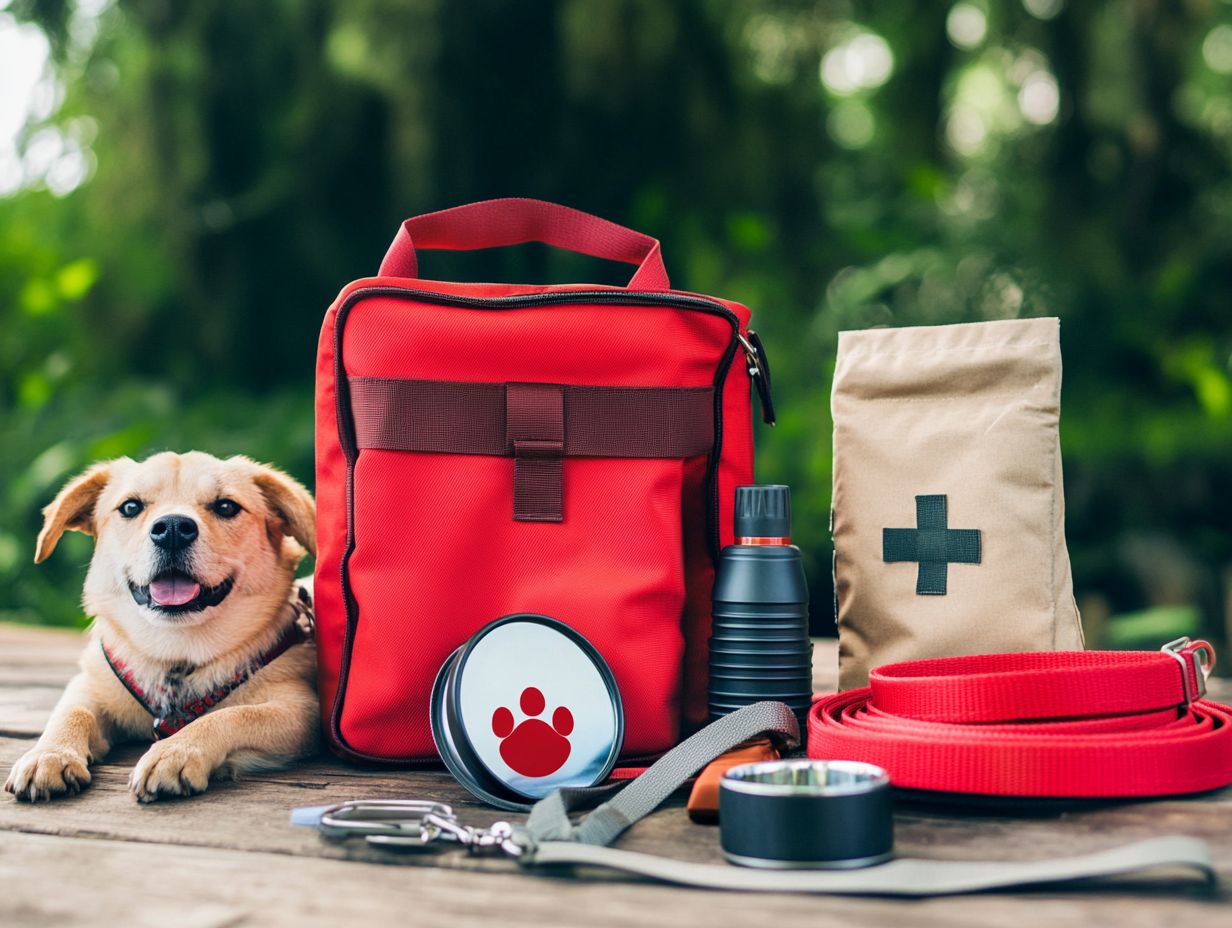
Implementing safety measures for your pet during an emergency is crucial. It minimizes risks and keeps your furry friend protected amid chaos.
As a pet owner, it s smart to take action to create a secure environment early on. Designating a specific area in your home can help your pets feel safe and comfortable.
Using crates or gates to limit their movement during stressful events is also beneficial. When faced with unfamiliar or potentially dangerous situations, employing a muzzle can prevent anxiety-driven reactions, safeguarding both your pet and those around you.
It s wise to keep emergency contact information handy, such as local veterinarians and pet hospitals. This ensures swift assistance when needed.
By considering these practical measures, you can significantly enhance the safety and well-being of your beloved companions.
5. Identification and Important Documents for Your Pet
Having proper identification and important documents for your pet is crucial in emergency situations. These not only help reunite lost pets with their owners but also navigate the legalities surrounding pet ownership.
Clear identification tags with your contact information and microchips provide a permanent solution for your pet’s safety. Microchips are tiny devices placed under your pet’s skin. They provide a permanent way to identify your pet if lost and can be scanned by vets or shelters to find your details.
Keeping essential documents accessible, like vaccination records and adoption papers, is vital during vet visits or travel preparations. Make sure your vital documents are easy to grab!
With this documentation, you can expedite care and ensure your pet receives necessary treatment, enhancing their well-being and reinforcing the special bond you share.
Why Is It Important to Have Identification for Your Pet?
Having proper identification for your pet is essential. It dramatically increases the likelihood of reuniting with them if they ever go missing, giving you invaluable peace of mind.
There are several effective methods of identification. Tags, typically attached to collars, showcase crucial information like your contact details. This allows anyone who finds your wandering pet to reach out quickly.
Microchips offer a more permanent and tamper-proof solution. These tiny devices are embedded under your pet’s skin and can be scanned by veterinarians or shelters to access your information.
Collars provide an extra layer of security. They not only secure the tags but also allow for easy attachment of a leash, making them the ultimate all-in-one solution for keeping your pet safe and identifiable if they wander off.
What Documents Should You Have for Your Pet in an Emergency?
Maintaining crucial documents for your pet is essential in emergencies. Easy access to veterinary records and health information helps expedite care and treatment for your furry friend when they need it most.
Being prepared with important paperwork think vaccination records, health certificates, and adoption papers can significantly reduce stress and confusion during unexpected situations.
For example, having vaccination records on hand confirms that your pet is up-to-date on essential immunizations. This is vital information for any new veterinarian caring for your beloved companion.
If you’re traveling or relocating, health certificates may be necessary to ensure your pet meets any required health standards. Having adoption papers readily available clarifies ownership and confirms your pet’s background when proof is needed.
These documents are not merely safeguards; they enable you to provide the best possible care when every second counts.
6. Tips for Preparing Your Pet for an Emergency
Preparing your pet for emergencies goes beyond merely gathering supplies; it demands proactive training and understanding how your pet might respond in crisis situations. This awareness can dramatically affect your response time and effectiveness during emergencies.
From practicing evacuation drills to familiarizing your pet with their emergency kit, the goal is to ensure they re ready to tackle any unexpected challenges that may come their way.
Begin by establishing a routine where your pet associates the emergency kit with positive experiences, such as treats or playtime. Incorporate practice runs for quickly leaving your home while maintaining a calm demeanor to encourage your pet to follow your lead. It s essential for your pet to feel comfortable with their harness, carrier, and other essentials, minimizing stress during actual evacuations. Familiarity with their surroundings and the plan can greatly help them stay composed.
Above all, prioritize your pet s safety by ensuring they are microchipped or wear a collar with ID tags. This simple step can be invaluable if you become separated during a crisis.
How Can You Train Your Pet for Emergency Situations?
Training your pet for emergency situations can significantly improve their behavioral response while providing you with peace of mind. It prepares them to stay calm and follow your commands even in the midst of unexpected chaos.
By incorporating various strategies, you can help your furry companion adapt to high-stress situations that might arise during emergencies. One essential technique is desensitization, where you gradually expose your pet to loud noises, like thunder or sirens, in a controlled environment. This helps them associate such sounds with safe experiences rather than panic.
Reinforcing basic commands like “sit,” “stay,” and “come” establishes a strong foundation for obedience. Regularly practicing evacuation drills at home can also familiarize your pet with the necessary movements and the importance of following you, ultimately reducing stress during real-life scenarios.
What Are Some Important Things to Remember When Evacuating with Your Pet?
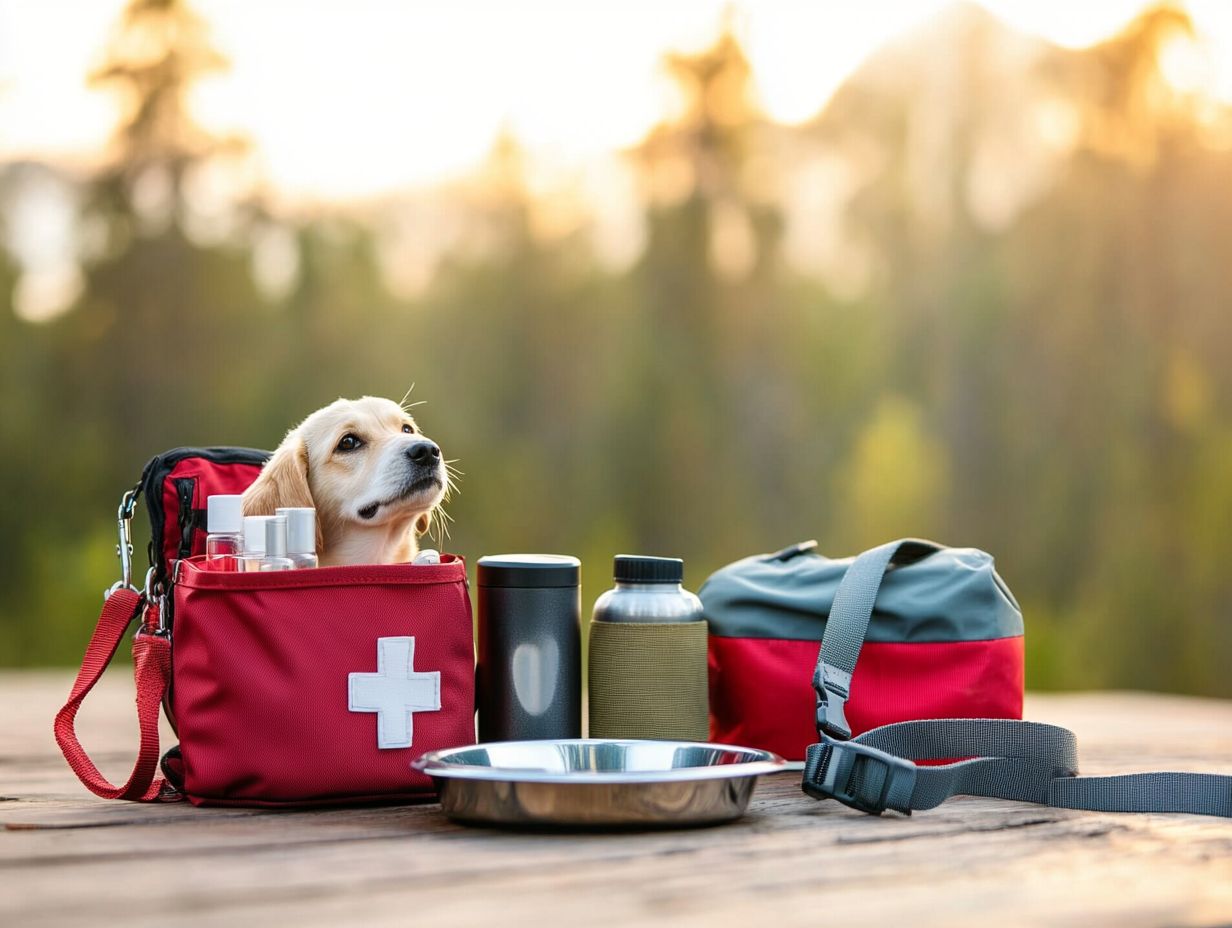
When you re evacuating with your pet, there are several crucial considerations to ensure their safety and well-being during what can often feel like a chaotic whirlwind.
Amid fleeing from an emergency, staying organized and prepared is very important.
- First and foremost, always keep your pet on a leash to prevent them from darting off amidst the commotion.
- Ensure they have proper identification whether it’s a collar with tags or a microchip so you can easily reunite if they get lost.
- Securing your transportation in advance can save you precious time during the evacuation.
- Having a pet carrier or travel crate ready helps to minimize stress for your pet and keeps them safe while you’re on the move.
- And don t forget their essentials, such as food, water, and any necessary medications.
Being prepared ensures your pet stays safe and comfortable, letting you focus on what matters most!
Watch this video to learn more about keeping your pet safe in emergencies.
Frequently Asked Questions
What is survival gear for pets in emergencies?
Survival gear for pets in emergencies refers to essential items and supplies that are specifically designed to help your pet survive during a disaster or emergency situation. These items can include food, water, first aid supplies, and other necessary items for your pet’s well-being in a crisis.
Why is it important to have survival gear for your pet in emergencies?
During a disaster or emergency, your pet may become separated from you or be unable to access their usual sources of food and water. Having survival gear specifically for your pet ensures they have the necessary resources to survive until help arrives.
What should be included in a pet’s emergency survival kit?
A pet’s emergency survival kit should include:
- At least three days’ worth of food and water
- Any necessary medications
- A first aid kit
- A leash and harness
- A carrier or crate
- Familiar items such as toys or blankets
- Your pet’s identification and medical records in a waterproof container
Prepare your pet s emergency kit today for peace of mind!
Can I use my own emergency supplies for my pet?
Some items from your emergency kit may work for your pet. However, it’s crucial to have specific supplies just for them.
For instance, human food might not be safe for pets. Certain medications could also be harmful.
Having a dedicated emergency kit for your pet is the best option.
How often should I check and update my pet’s emergency supplies?
You should check your pet’s emergency supplies at least twice a year. Update them whenever your pet s needs or routine change.
This practice ensures all items are usable and current. Your pet will be ready in case of an emergency.
Can I make my own survival gear for my pet in emergencies?
Yes, you can create your own survival gear for your pet. However, do thorough research and talk to your vet first.
This will help ensure that your items are safe and suitable. It’s wise to have a professional emergency kit as a backup.

